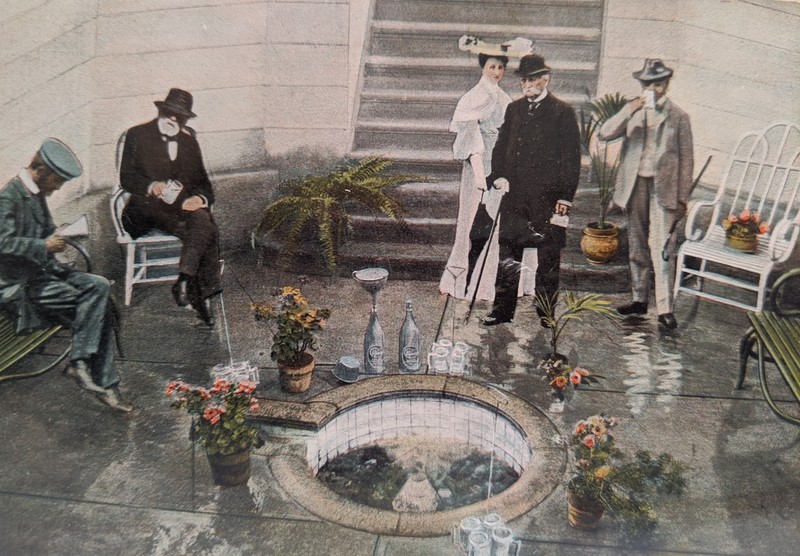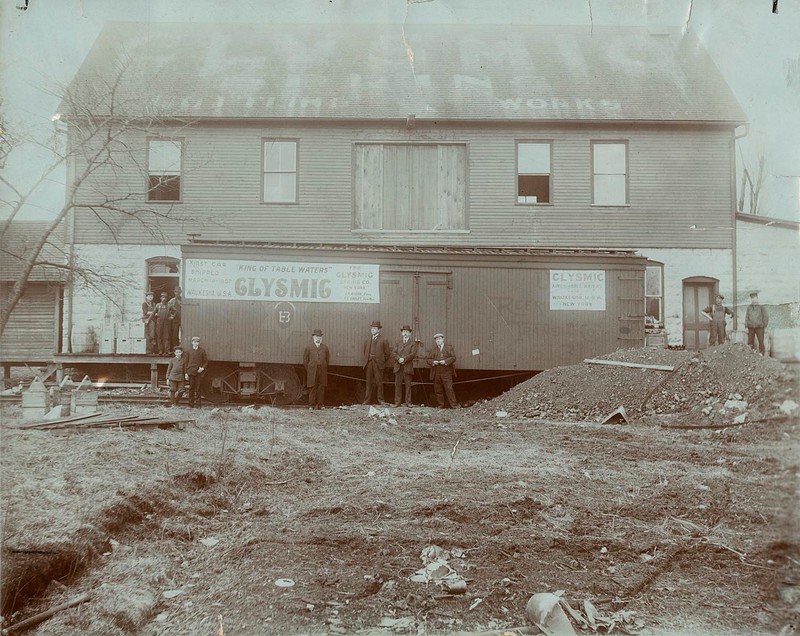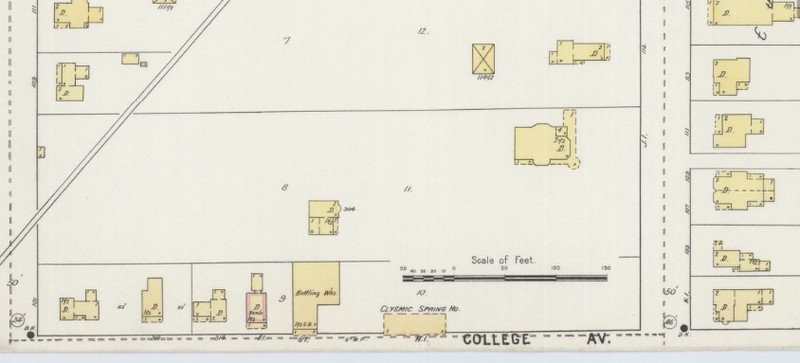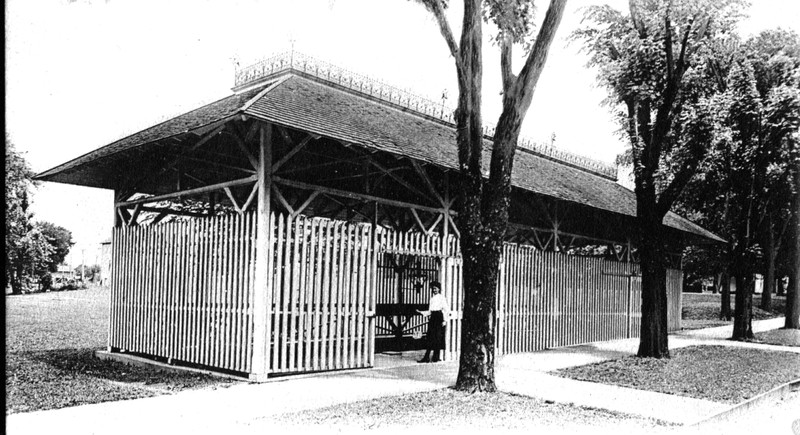Clysmic Spring
Introduction
Text-to-speech Audio
Clysmic Spring was owned by Mrs. Kate Hill of Natchez, Mississippi and leased to Judge John L. Lockwood of New York in 1879. Named Clysmic, which means cleansing, the spring was located at the northwest corner of Grand and College Avenues. After a court battle over the contract and ownership of the name “Clysmic,” Mrs. Hill sold the spring in 1906. The new owners saw renewed success for the company, advertising Clysmic Spring as the “King of Table Waters” bottling in a distinctive green glass bowling pin shapped bottle. Unfortunately, a fire swept through the bottling plant in 1915 and by 1920 Clysmic water was no longer being sold.
Images
Visitors gathered at Clysmic Spring

Clysmic Spring Bottling Plant

1895 Map showing location

The Clysmic Springhouse from the outside

Backstory and Context
Text-to-speech Audio
Mrs. Kate Hill of Natchez, Mississippi, widowed weeks after her marriage, visited Waukesha as a summer tourist to the springs and resorts of the area. Impressed by the town, and the opportunity for inveestment, she purchased the Clysmic Spring property in 1879 from Samuel W. Warner and Alice E. Showerman. The year prior, Warner and Showerman had entered a lease agreement with Judge John L. Lockwood of New York to give him exclusive rights to operation of spring, which he named Clysmic meaning cleansing. Upon the purchase of the spring, Hill took over the operating lease agreement with Lockwood giving him exclusive rights to the spring for 20 years.
Improvements to the spring were made in the 1880's. A pavilion or spring house was built atop the spring to protect the water from outside contaminants such as leaves or rain. Lockwood had the water from the Clysmic spring shipped to New York via tank car and bottled there, where it was sold in high end hotels and restaurants. In his agreement with Hill, he paid her per barrel of water shipped to New York.
By 1887, Clysmic’s popularity had grown on the east coast, but Mrs. Hill noticed a reduction in the amount of royalties she was being paid. Mrs. Hill investigated this discrepancy and uncovered evidence that Lockwood had purchased a nearby property and dug his own "spring," claimed that it was the true "source" of Clysmic, and started selling the water under that name in 1884. A court battle ensued. Armed with evidence of the number of barrels of water shipped to New York, Mrs. Hill prevailed in both rights to the brand name and money due for the water collected from the nearby “spring” and sold under the Clysmic brand. The ruling did not cancel the 1879 lease contract allowing Lockwood to operate and sell water from the original site. The court felt that Lockwood could use the Clysmic name if he bottled water from that spring, but if he bottled water from his own spring he was instructed to use a different name.
It is unclear what type of relationship Hill and Lockwood had after the lawsuit was settled. It seems like different names were used for both Lockwood’s Clysmic spring and a third spring nearby. In 1905, Lockwood sold his property including his spring he named Kaludor Spring to Mrs. Hill, who had remarried and was Mrs. Van Rensellaer. In September 1906, Mrs. Van Rensallaer ended her 28 year ownership of Clysmic Springs by selling her property to New York capitalists Earl A Carley and J. H. Ahren. In January of 1907, she passed away.
The new owners began bottling the water in Waukesha at the spring installing modern bottling equipment, and introduced a unique green bowling pin shaped bottle for the brand. A new trademark featured a nubile woman sitting next to an elk, dipping her feet in a clear pool of water. An renewed advertising campaign dubbed Clysmic "The King of Table Waters," as advertised in magazine ads, tip trays, signs, bar wares, and novelties like decks of cards.
A setback occurred in 1915 when a fire swept through the bottling plant causing $10,000 in damages. Though the company wanted to expand and continue on after the fire, on October 30th, 1919 articles of dissolution were filed at the Waukesha County Courthouse. The larger White Rock Spring Company, also of Waukesha, bought the rights to the brand, and site after the dissolution. All bottling of water at the original Clysmic Spring ceased. White Rock continued the brand briefly in1920's, but eventually allowed the brand to fall off production.
Sources
Waukesha Landmarks Commission. A Thematic History of Waukesha, January 1st 2002. Accessed September 27th 2020.
Schoenknecht, John Martin. Great Waukesha Springs Era 1868-1914. Edition 3. Waukesha, WI. John M. Schoenknecht, 2022.
Waukesha Freeman, Waukesha, Wisconsin, June 27, 1878
Waukesha Freeman, Waukesha, Wisconsin, January 31, 1907
Circuit Court E.D. Wisconsin. Hill vs. Lockwood and others, June 24th 1887. Accessed February 26th 2022. https://law.resource.org/pub/us/case/reporter/F/0032/0032.f.0389.html.
Waukesha County Historical Society & Museum
Wisconsin Historical Society
1895 Sanborn Map Section
Waukesha County Historical Society & Museum
